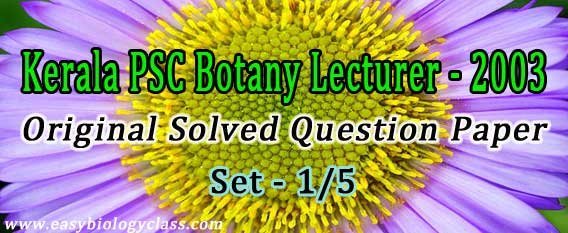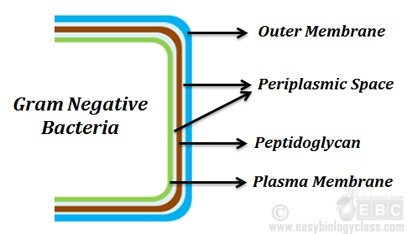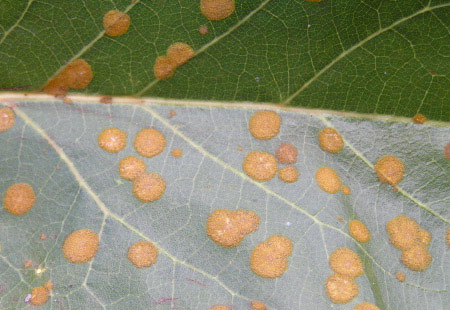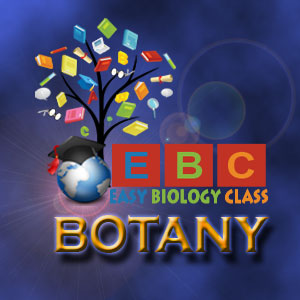
Kerala PSC Botany Lecturer / Assistant Professor Question Paper (250/2003)
Original solved question paper of Kerala PSC Botany Lecturer/Assistant Professor examination conducted by Kerala PSC (Kerala Public Service Commission) for the appointment of Botany Lecturer/Assistant Professor in Government Colleges of Kerala under the Directorate of Collegiate Education, Trivandrum, Kerala. Question Paper Code Number 250/2003. Questions are in MCQ (Multiple Choice Questions) format. Detailed answer key with explanations are given at end of each set.
Part – 1/5 (Questions 1 – 20)
1. Shuttle vectors are:
a. Capable of replicating in two different hosts
b. Produce in two different hosts
c. Produced in one microbe but multiply in another
d. Travel between host and parasite
2. The outer layer of the cell wall in gram negative bacteria is
a. Secondary wall layer
b. Primary wall membrane
c. Peri-plasmic membrane
d. Capsule membrane
3. A bacterium used as bio-insecticide by creating a transgenic plant:
a. Bacillus thuringiensis
b. Streptococcus cremoris
c. Bacillus licheniformis
d. Thiobacillus cervicii
4. The heat content which is exchanged between isothermal system and its surrounding in bioenergetics change is described as:
a. Entropy change
b. Activation energy change
c. Free energy change
d. Enthalpy change
5. Carpogonia are:
a. Diploid structures
b. Haploid structures
c. Triploid structures
d. Tetraploid structures
6. ‘Kappa’ particles are:
a. Extra chromosomal DNA of cytoplasm
b. Non-functional DNA of cytoplasm
c. Essential genomic DNA of the cell
d. Non-essential genomic DNA of the cell
7. Which of the following is not the character of leg-hemoglobin?
a. Very high affinity for oxygen
b. Direct role in nitrogen fixation
c. Present in all symbiotic nitrogen fixing plants
d. Synthesized by the plant genome
8. The man made cereal ‘Triticale’ is
a. Hexaploid
b. Diploid
c. Haploid
d. Tetraploid
9. Carrageenan is:
a. An algal product
b. A fungal product
c. A product of Carryota urens
d. Produced from carraya gum
10. ‘Chromosome Walking’ can be used for:
a. Construction of restriction maps
b. An effective tool for gene splicing
c. Identification of fragments with overlapping sequences
d. Chromosome hybridization
11. Primed synthesis method of DNA sequence was developed by:
a. Maxam and Gilbert
b. Sanger and Coulson
c. Meselson and Stahl
d. Hershey and Chase
12. Red rust of tea is a:
a. Fungal disease
b. Bacterial disease
c. Viral disease
d. Algal disease
13. ‘Reindeer moss’ can accumulate radioactive fallout. It is
a. Sphagnum
b. Cladonia
c. Funaria
d. Usnea
14. E. coli is a :
a. Gram negative bacterium
b. Gram positive bacterium
c. Gram neutral bacterium
d. None of these types
15. Toxoids are:
a. Chemically altered toxins
b. Chemicals that act against toxins
c. Chemicals similar to toxins
d. Synthetic chemicals used as toxins
16. Biological nitrogen fixation in heterocyst of Nostoc is due to:
a. Presence of nitrogenase in the heterocyst
b. Presence of leg-hemoglobin in the heterocyst
c. Presence of Fe-Mn cofactor in the heterocyst
d. Presence of an aerobic condition inside the thick heterocyst
17. Pollen grains with elongated furrow perpendicular to the long axis in the sexine is called as:
a. Sulcate
b. Rugate
c. Porate
d. Colpate
18. Discrete cytoplasmic slime bodies are seen in:
a. Parenchyma cells
b. Reaction wood
c. Bast fibres
d. Sieve tubes
19. Secondary metabolite production in cultured cells is stimulated by:
a. Sucrose
b. PEG
c. Elicitors
d. 2,4,-D
20. ‘Ashwagandha’ belongs to the family
a. Solanaceae
b. Verbenaceae
c. Asteraceae
d. Rubiaceae
Kerala PSC Botany Lecture Exam 2003 Question Paper
| Part – 1/5 | Part – 2/5 | Part – 3/5 | Part – 4/5 | Part – 5/5 |
Answer Key and Explanations
The answer key is prepared with best of my knowledge and all of them may not be correct. If you find any mistakes in my decision, you are welcome to point it out and it will be appreciated.

1. Ans. (a). Capable of replicating in two different hosts
Shuttle vectors are usually plasmid vectors, they are constructed in such a way that it can replicate in two different host cells. Thus the DNA inserted into a shuttle vector can be tested or manipulated in two different cell types.
2. Ans. (d). Capsule membrane
Capsule is also called as slime layer
Learn more: Gram +ive vs Gram –ive Bacteria: Similarities and Differences
3. Ans. (a). Bacillus thuringiensis
B. turingiensis is a soil dwelling gram negative bacteria with insecticidal properties. This bacterium naturally occurs in the gut of the caterpillars of some moths and butterflies. During the sporulation, B. turingiensis produce an endotoxin called cry protein (crystal protein) encoded by the cry gene which is usually resides in the plasmid (not in the chromosome) in the bacteria. This insoluble endotoxin, as crystals, is dissolved by the alkaline pH in the gut of insect caterpillars and cleaved by the proteinase enzyme to release the toxin. This toxin binds to the insect gut cell membrane, paralyzing the digestive tract and induces the formation of pores in the gut. The insect stops eating and starves to death and this cry-protein acts as a natural insecticide. This property is tapped in producing genetically modified crops such as Bt cotton or Bt Brinjal by transferring cry-gene to crop plants to produce the endotoxin and thereby make these plants resistant to a wide variety of insects.
Streptococcus cremoris is the old name of Lactococcus lactis, a gram positive bacterium extensively used in the production of buttermilk and cheese. L. lactis is the first genetically modified organism to be used alive for the treatment of human diseases.
Bacillus licheniformis: a gram positive soil bacteria also found in the feathers of birds
4. Ans. (a). Entropy change
Entropy change: the degree of disorder or randomness in the system. It is actually a thermodynamic quantity representing the unavailability of a system’s thermal energy for conversion into mechanical work. The second law of thermodynamics says that the entropy always increases with time. In thermodynamics, entropy is represented as S.
Entropy change: The entropy change of the surroundings is driven by heat flow and the heat flow determines the sign of ΔSsurr. Therefore if we had an exothermic reaction with a constant temperature the system would cause heat to flow into the surroundings, which causes ΔSsurr to become positive. In an endothermic reaction, the opposite condition of the above can be visualized.
Enthalpy: denoted as H, the thermodynamic quantity representing the total heat content of a system which is equal to the sum of internal energy of the system and product of pressure and volume. The accepted SI unit of the measure of enthalpy is joule.
Enthalpy change: amount of heat evolved or absorbed in a reaction carried out at constant pressure, denoted with the symbol ΔH
Free energy: better known as Gibbs free energy, is the energy available in a system to do work, denoted as G
Free energy change: denoted as ΔG is the sum of the enthalpy plus the product of the temperature and entropy of the system.
Activation energy: the minimum energy required for the reactants to start a chemical reaction. Enzymes perform its catalytic functions by reducing the level activation energy of the reactants.
5. Ans. (b). Haploid structures
Carpogonium is the female reproductive structure of some red algae such as Polysiphonia which shows complex Haplo-diplobiontic life cycle, a triphasic life cycle with two diploid stages (carposporophyte and tetrasporophyte) and one haploid phase (gametophyte). Carpogonium is developed on the haploid plant called gametophyte, developed by the germination of the haploid tetraspores. The famous post-fertilization changes occur in the carpogonium after fertilization. The structures like cystocarp, carposporangium and carposores are all diploid structures developed from the carpogonium after fertilization.
Learn more: Different types of Life Cycles in Algae
6. Ans. (a). Extra chromosomal DNA of cytoplasm
Inheritance of Kappa particles is a classic example of cytoplasmic inheritance
7. Ans. (c). Present in all symbiotic nitrogen fixing plants
Leghemoglobin is an oxygen carrier hemoprotein with high affinity towards oxygen. Presence of oxygen reduces the activity of nitrogenase activity. The heme group and the apoprotein part of the enzyme are produced by the plant genome only in response to Rhizobium infection. The affinity of leghemoglobin towards oxygen is Km ~ 0.01 µM which is about ten time than the affinity of oxygen towards hemoglobin of blood.

8. Ans. (d). tetraploid
Triticale, better known as ×-Triticosecale is an artificial hybrid between wheat (Triticum) and rye (Secale). It is a fertile allopolyploid (amphidiploid) which can undergo sexual reproduction to produce grains. Triticale has many superior qualities than both Triticum and Secale such as increased grain size, disease resistance, lodging resistance, environmental tolerance.
Hexaploid triticale is also available
9. Ans. (a). An algal product
Carrageenan: is a sulfated polysaccharide extracted from Chondrus crispus (Irish Moss), a marine red algae. Carrageenan has widely used in food and dairy industry for their gelling, thickening, and stabilizing properties.
10. Ans. (c). Identification of fragments with overlapping sequences
Chromosome walking: (now known as Primer Walking): A method to sequence DNA sequences of large length such as between 1.5 and 7 kilobases. The conventional chain termination sequence method can sequence only a distance of 100 to 1000 base pairs. The technique of chromosome walking or primer walking used the same chain termination sequence method, however, in somewhat different way sequential steps. First pair of primer sequences a short distance of DNA. In the second sequencing cycle, one of the primers synthesized will be based on the sequence near to the end of the first sequence. In this way, the whole length of DNA can be sequenced by primer waling. The sequences obtained from each cycle are aligned using any alignment tools to obtain the whole sequence. When the primer walking method is used for sequencing the whole chromosome, the term chromosome walking is used. A slightly modified method called shotgun method is used for sequencing the whole genome of the organism. The human genome project was completed by shotgun sequencing method.
11. Ans. (b). Sanger and Coulson
Maxam and Gilbert: Chemical method of DNA sequencing
Meselson and Stahl: Proved the semi-conserved model of DNA replication by using normal and heavy nitrogen
Hershey and Chase: Proved that DNA is the genetic material by their classic experiment using radioactive labeled P and S

12. Ans. (d). Algal disease
Red rust in tea is caused by Cephaleuros virescens, a green algae.
13. Ans. Cladonia
Reindeer moss (cup lichen): Cladonia – lichen
Horse tail: Equisetum – Pteridophyte
Club moss: Lycopodium – Pteridophyte
Iceland moss: Cetraria islandica – lichen
Quillwort: Isoetes – Pteridophyte
Lesser club:moss – Selaginella
Hornworts: Anthoceros – Bryophyte
Liverworts: Marchantiales (Riccia, Marchantia etc.)
Irish moss: Chondrus crispus – algae
Pond silk: Spirogyra – algae
Peat moss or bog moss: Sphagnum – Bryophyte
Maidenhair tree: Ginkgo bioloba – Gymnosperm
Maidenhair fern (waling fern): Adiantum – Pteridophyte

14. Ans. (a). Gram negative bacterium
Examples of Gram positive bacteria: Actinomyces, Bacillus, Clostridium, Corynebacterium, Lactobacillus, Mycobacterium, Staphylococcus and Streptococcus
Examples for Gram negative bacteria: Escherichia coli, Agrobacterium tumefaciens, Helicobacter, Klebsiella pneumonia, Nitrosomonas, Pseudomonas, Rickettsia, Salmonella and Vibrio cholera
15. Ans. (a). Chemically altered toxins
Toxoids are chemically modified toxins from pathogenic microorganism. Toxoids are no longer pathogenic, but they are antigenic and elicit immunological reactions in the host and thus can be used for vaccination programmes.
16. Ans. (a). Presence of nitrogenase in the heterocyst
17. Ans. (I do not know the answer, if anyone knows the answer please inform me)
Sexine: outer part of the pollen wall exine
Sulcate: Pollen grains marked with long parallel furrows
Rugate: wrinkled pollen
Porate: pollen with one or more pores
Colpate: pollen grains with elongated apertures, elongation parallel to the long axis
18. Ans. (d). Sieve tubes
Slime bodies: Sieve tubes of some dicot plants contain variable amount of proteinaceous slimy substances which are organized as discrete bodies called slime bodies. Slime bodies occur either singly or in groups of varying shapes. In young stem, they are arranged as thick tubes and are called as P1-proteins. In mature sieve tubes, they are arranged as stratified fibres called P2-proteins. Function of P proteins: assist in the formation of plug to block the phloem during injury or abscission.
19. Ans. (c). Elicitors
Elicitors: they are compounds of natural origin, used to induce the production of secondary metabolites in callus. A variety of endogenous, exogenous and environmental factors can act as elicitors depending upon the callus type and secondary metabolite.
Examples of elicitors:
Endogenous elicitors (produce by the callus itself): pectin, pectic acid, cellulose, and other polysaccharides
Exogenous elicitors: (usually produced by some microbes): chitin, chitosan, glucans
Environmental factors which can acts as elicitors: cold, heat, UV light, osmotic pressure, ethylene, fungicides, antibiotics and salts of heavy metals.
20. Ans. (a). Solanaceae
Ashwagandha is Withania somnifera. It is medicinal plant used in Ayurvedic preparations.
